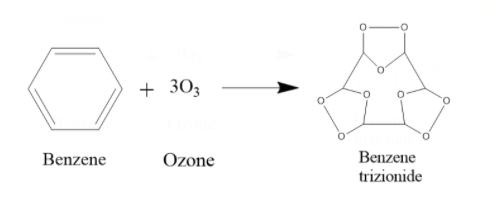
Benzene on ozonolysis followed by reaction with Zn +
(A) 3 moles of glycerol
(B) 3 moles of glyoxal
(C) 3 moles of glyoxalic acid
(D) 3 moles of acetylene
Answer
434.4k+ views
2 likes
Hint: Ozonolysis gives a product in which the double bonds are replaced with an ozone molecule. Zn +
Complete step by step solution:
i) Ozonolysis is an organic reaction in which the oxidative cleavage of an unsaturated bond in a compound occurs when reacted with ozone. The end product will be an organic compound in which multiple carbon – carbon bonds have been replaced with bonds to oxygen.
ii) Here we have to find the end product for ozonolysis of benzene, followed by reaction with Zn +
iii) Let us first see what the product will be after ozonolysis of benzene. During ozonolysis of benzene, what happens is an ozone is added to each pi bond of the benzene. Hence the product will be such that in the place of a double bond, there will be 2 O atoms attached as a chain outside the ring in between the 2 C atoms, and there will be an O atom inside the ring in between the C atoms. The product will be Benzene trizionide.

Next, the Benzene trizionide reacts with Zn +

Therefore, the answer is option (B) 3 moles of glyoxal.
Note: Make sure that you balance the equations. Only then, do you get the correct answer. The correct structure of benzene trizionide is the one in the question. You might see many different structures of this everywhere. Make sure that the structure you use has satisfied octet configuration.
Complete step by step solution:
i) Ozonolysis is an organic reaction in which the oxidative cleavage of an unsaturated bond in a compound occurs when reacted with ozone. The end product will be an organic compound in which multiple carbon – carbon bonds have been replaced with bonds to oxygen.
ii) Here we have to find the end product for ozonolysis of benzene, followed by reaction with Zn +
iii) Let us first see what the product will be after ozonolysis of benzene. During ozonolysis of benzene, what happens is an ozone is added to each pi bond of the benzene. Hence the product will be such that in the place of a double bond, there will be 2 O atoms attached as a chain outside the ring in between the 2 C atoms, and there will be an O atom inside the ring in between the C atoms. The product will be Benzene trizionide.

Next, the Benzene trizionide reacts with Zn +

Therefore, the answer is option (B) 3 moles of glyoxal.
Note: Make sure that you balance the equations. Only then, do you get the correct answer. The correct structure of benzene trizionide is the one in the question. You might see many different structures of this everywhere. Make sure that the structure you use has satisfied octet configuration.
Recently Updated Pages
Master Class 4 Maths: Engaging Questions & Answers for Success

Master Class 4 English: Engaging Questions & Answers for Success

Master Class 4 Science: Engaging Questions & Answers for Success

Class 4 Question and Answer - Your Ultimate Solutions Guide

Master Class 11 Economics: Engaging Questions & Answers for Success

Master Class 11 Business Studies: Engaging Questions & Answers for Success

Trending doubts
Give 10 examples of unisexual and bisexual flowers

Draw a labelled sketch of the human eye class 12 physics CBSE

a Tabulate the differences in the characteristics of class 12 chemistry CBSE

Differentiate between homogeneous and heterogeneous class 12 chemistry CBSE

Why is the cell called the structural and functional class 12 biology CBSE

Differentiate between insitu conservation and exsitu class 12 biology CBSE




